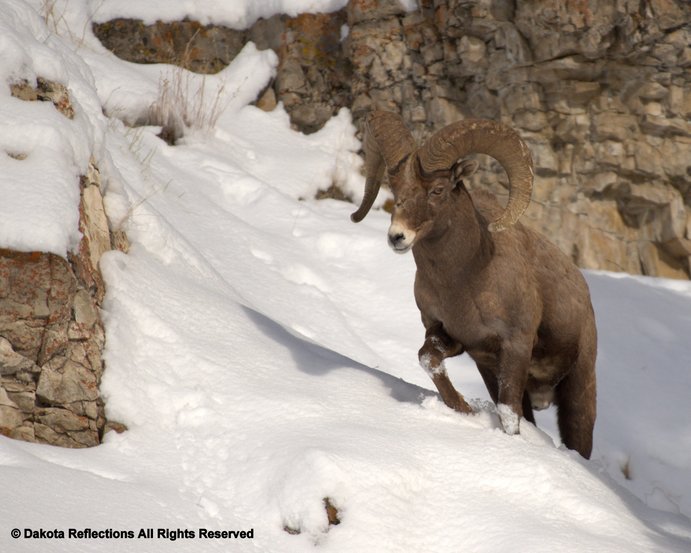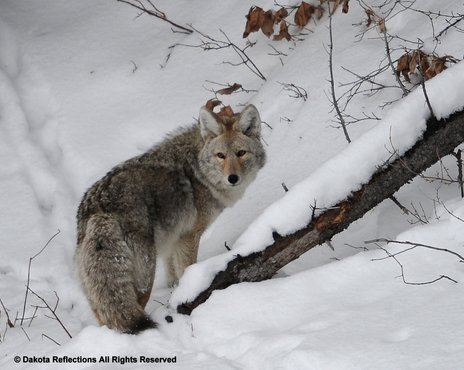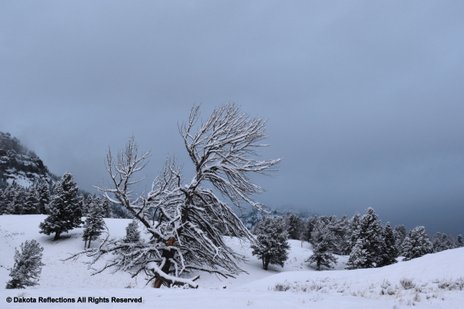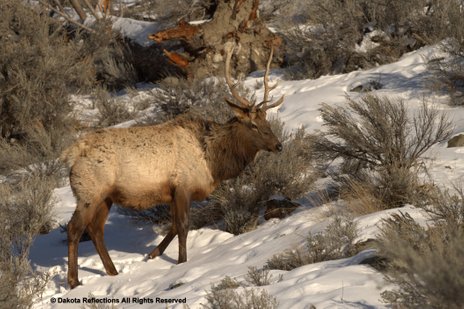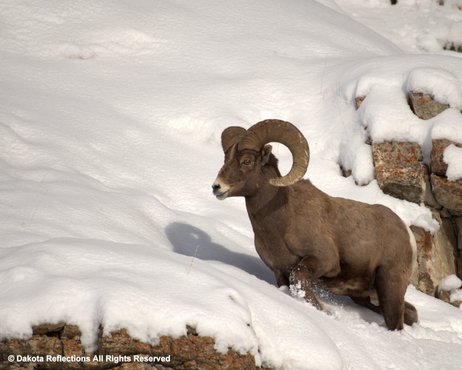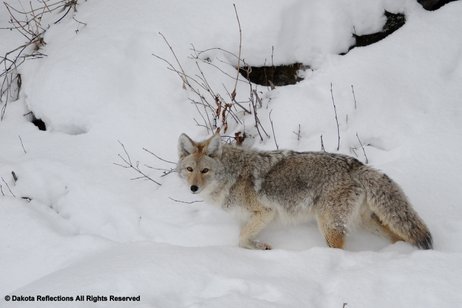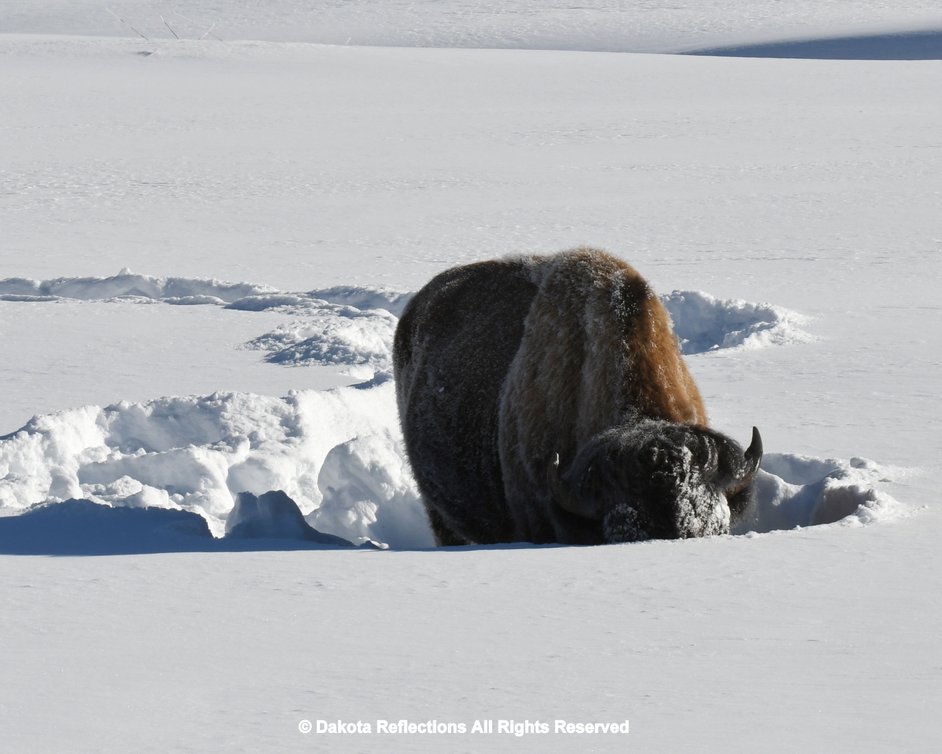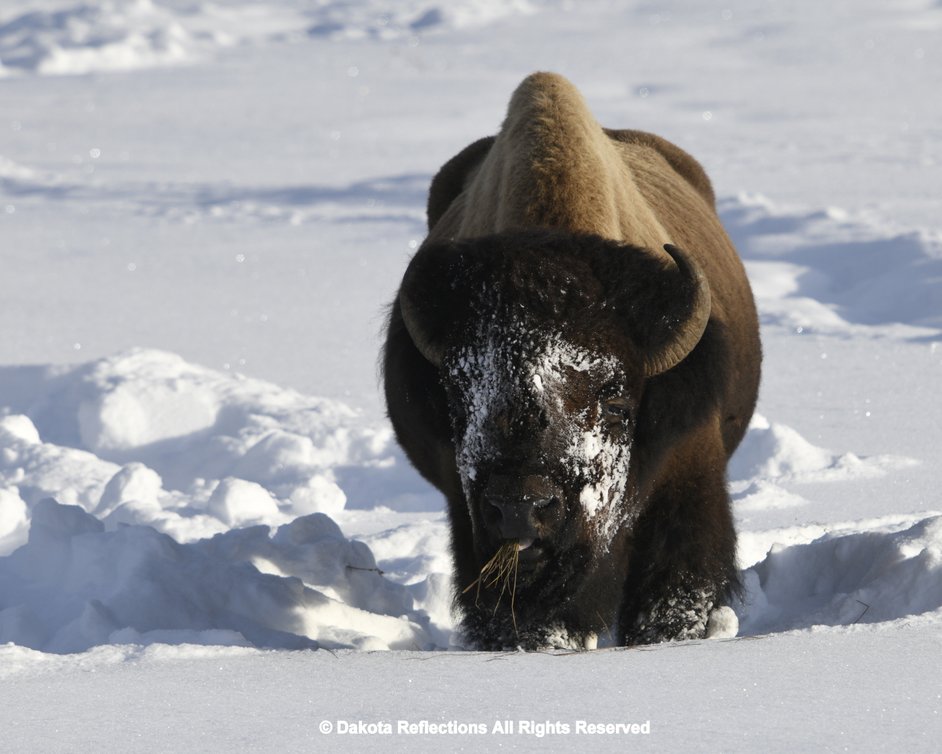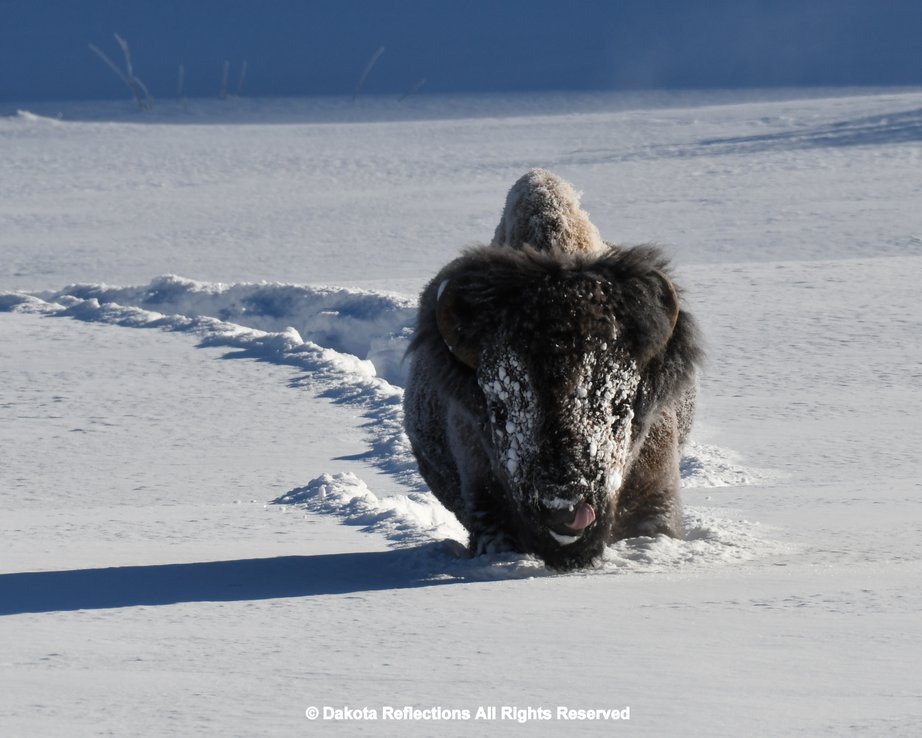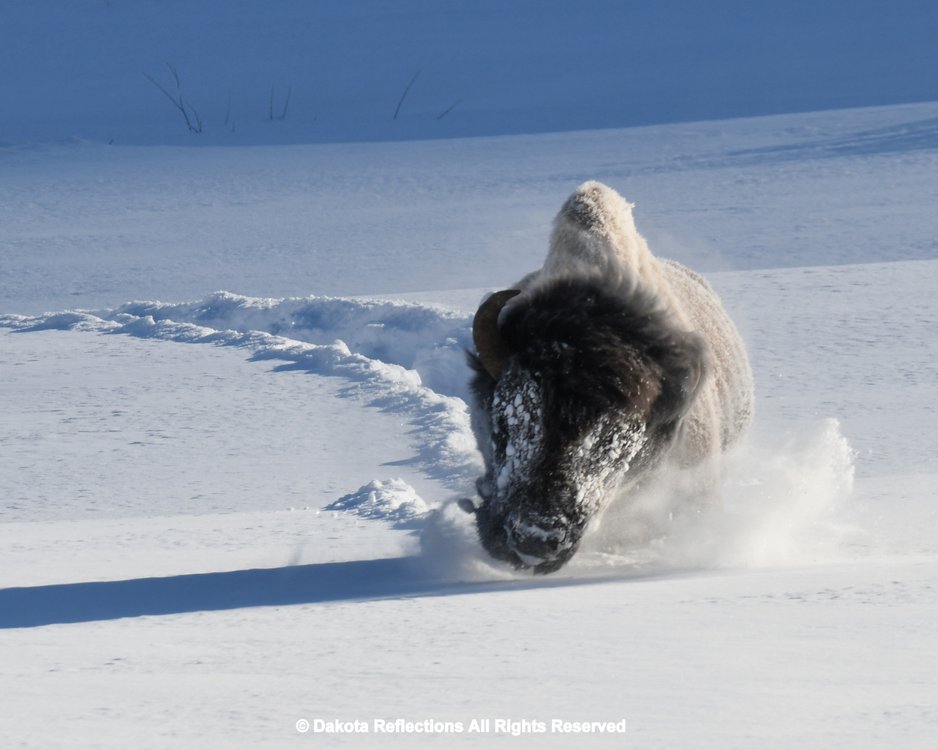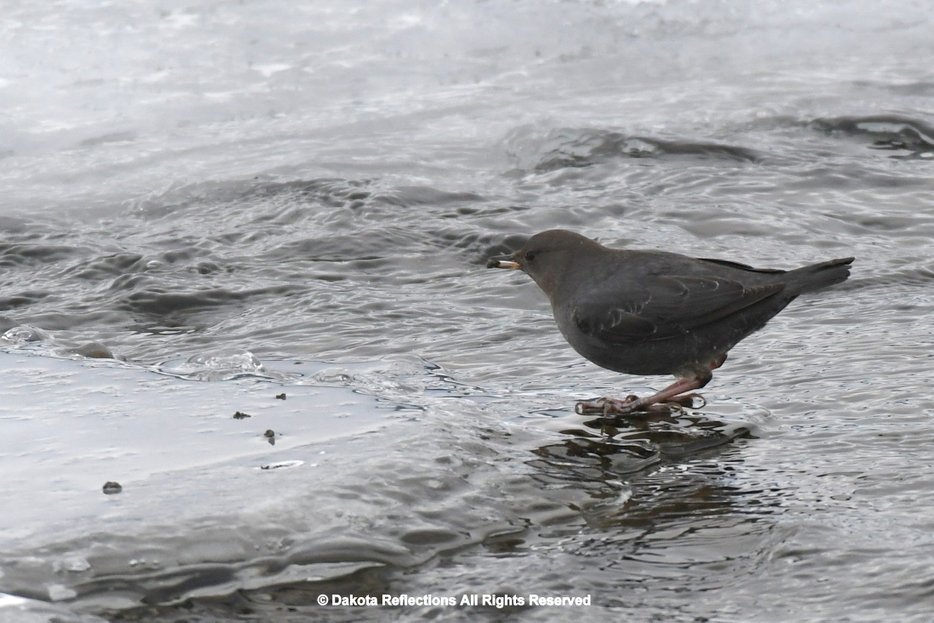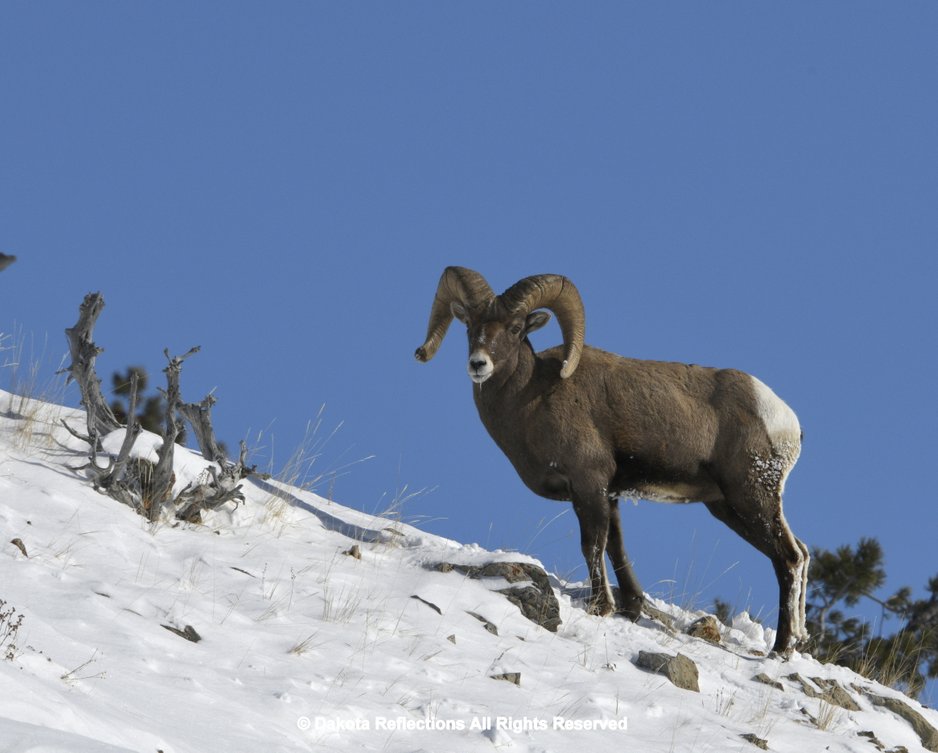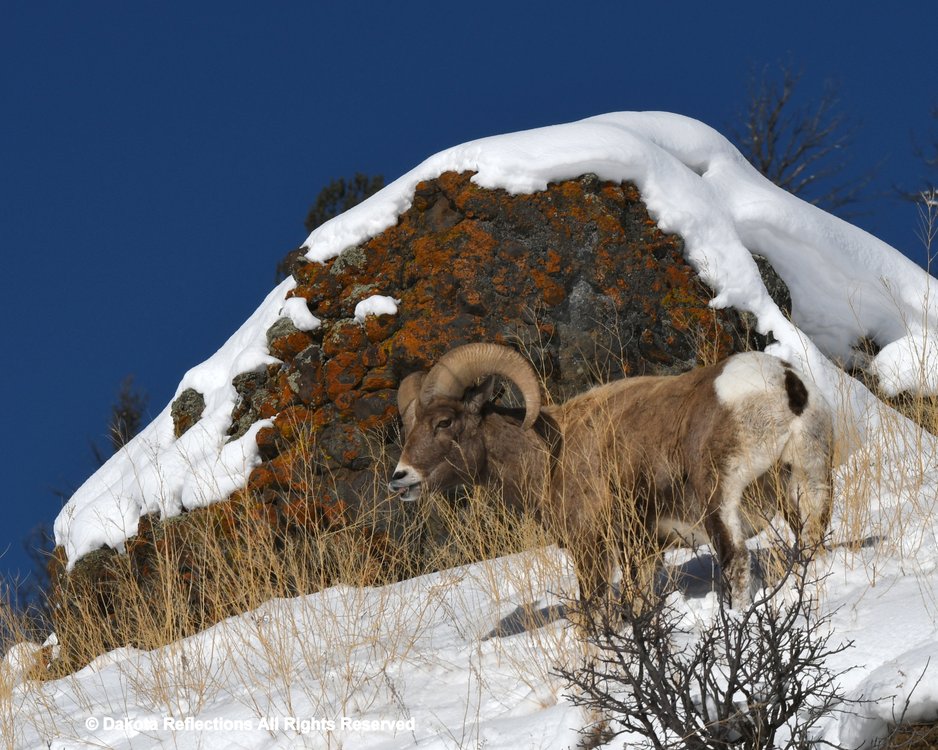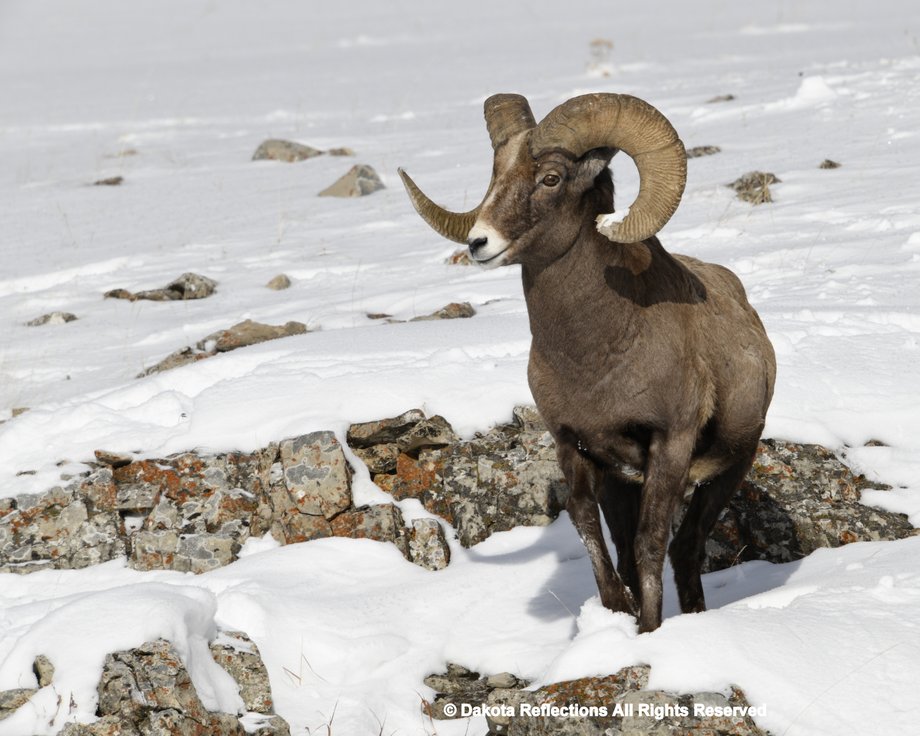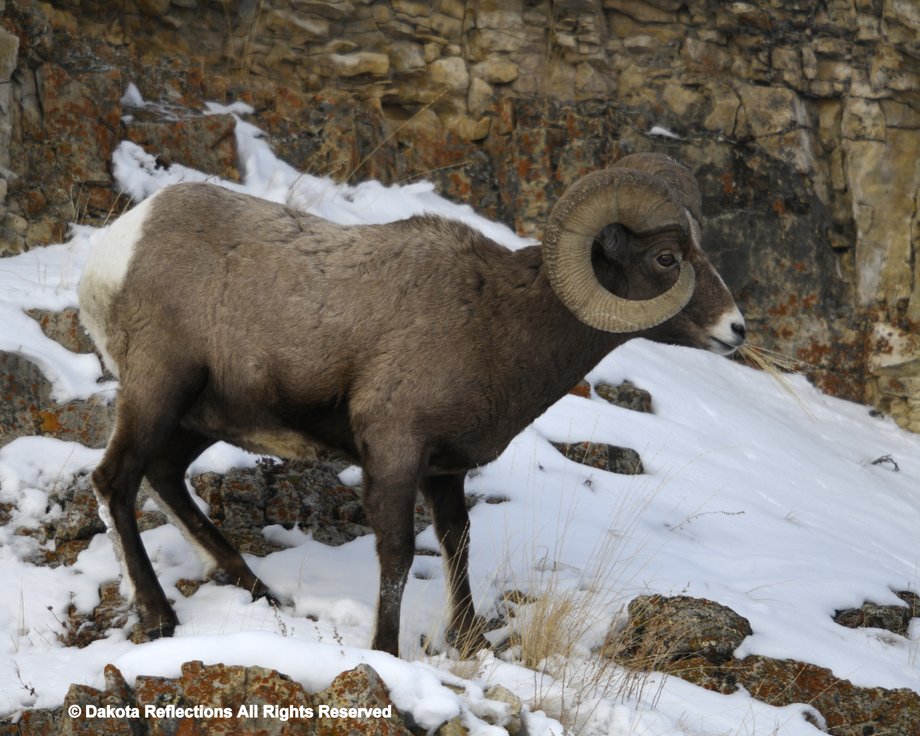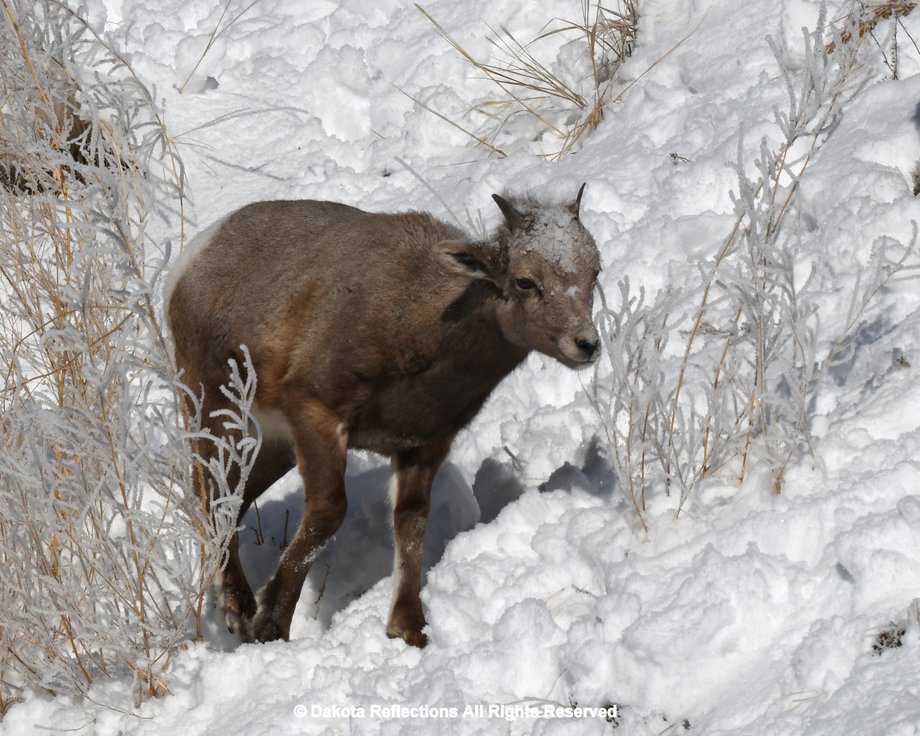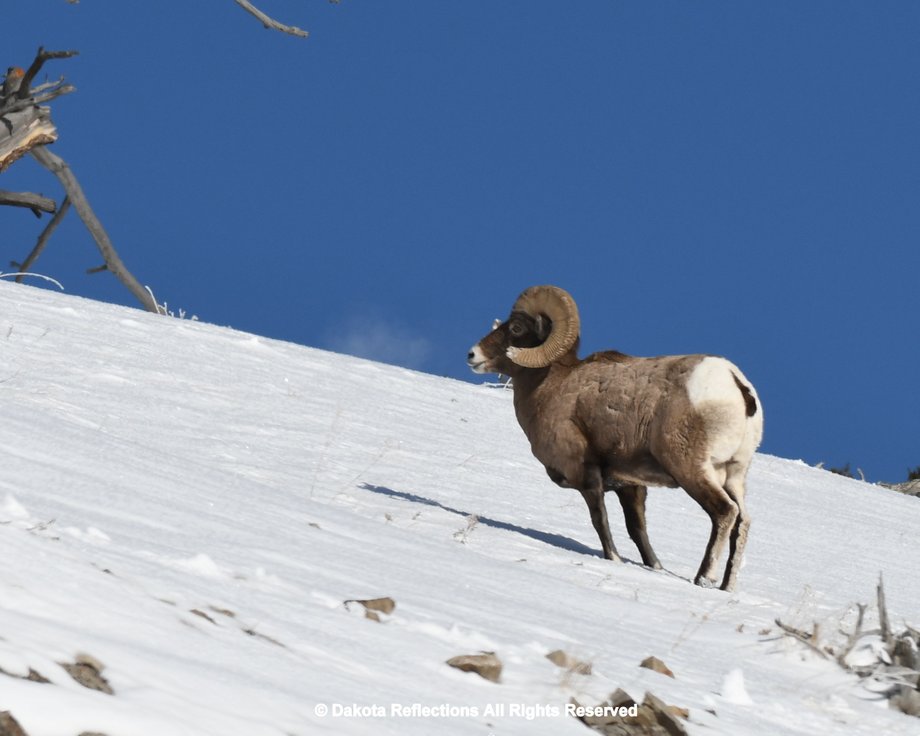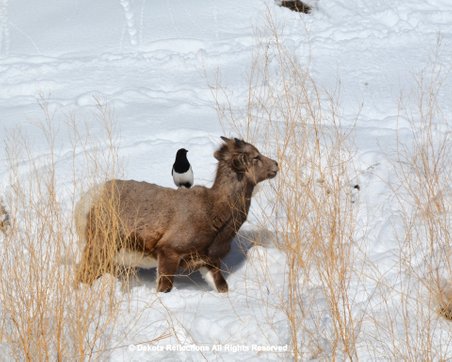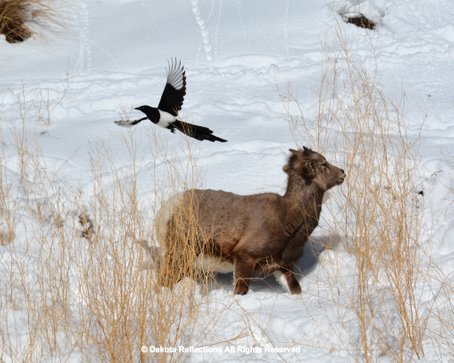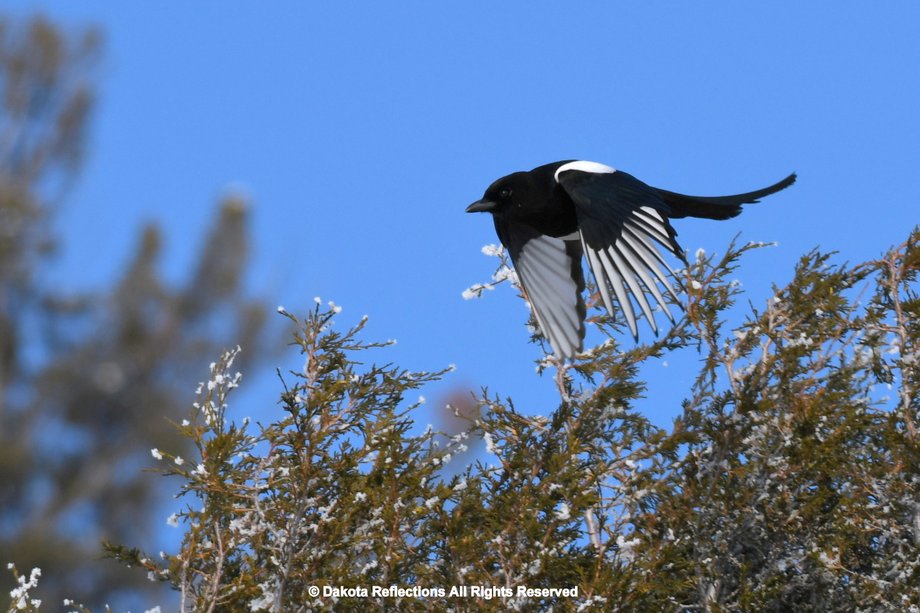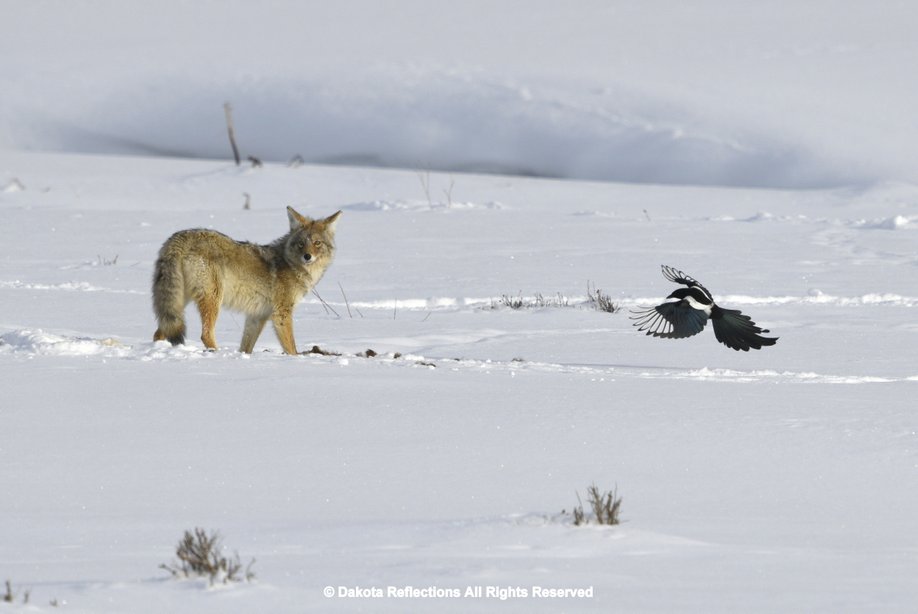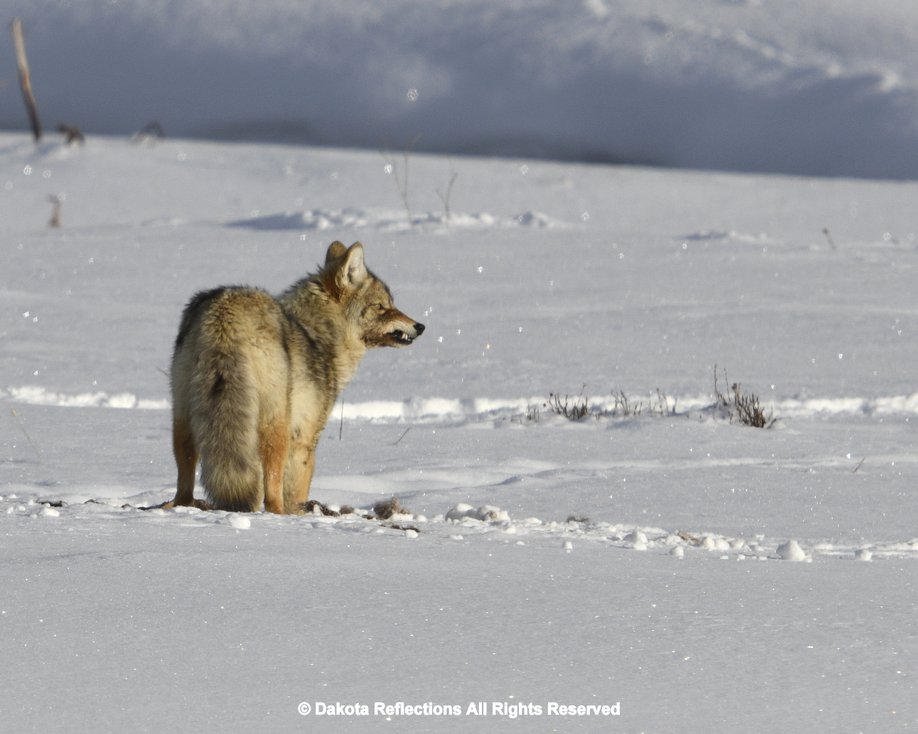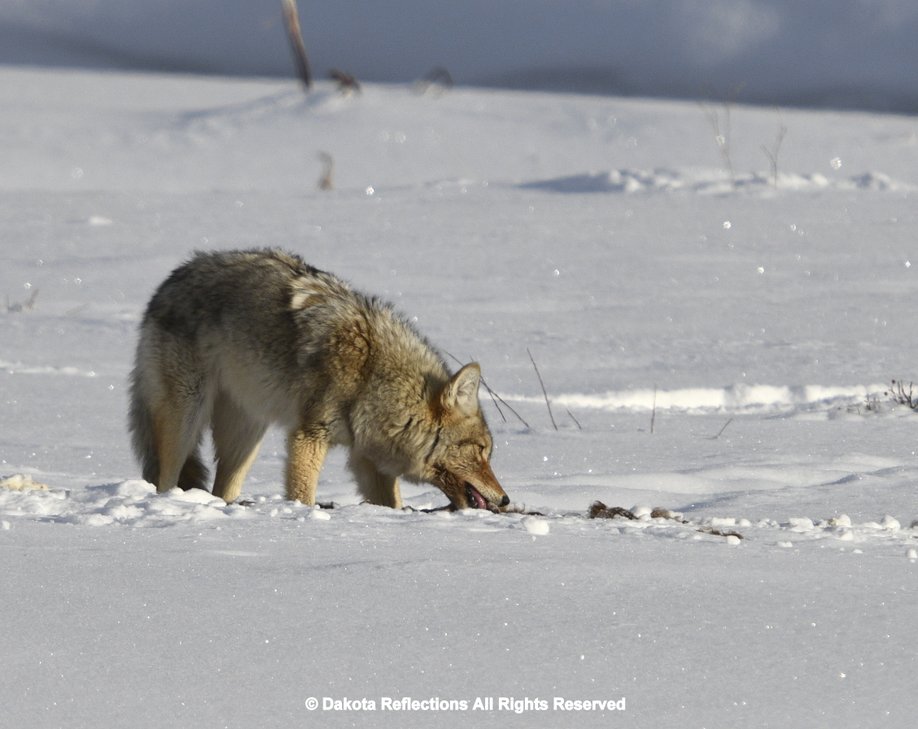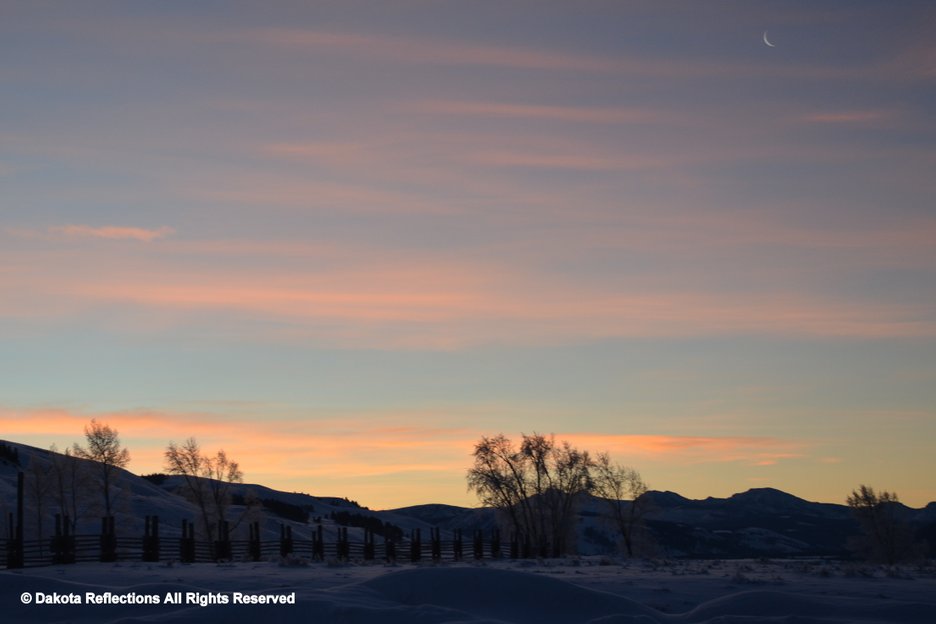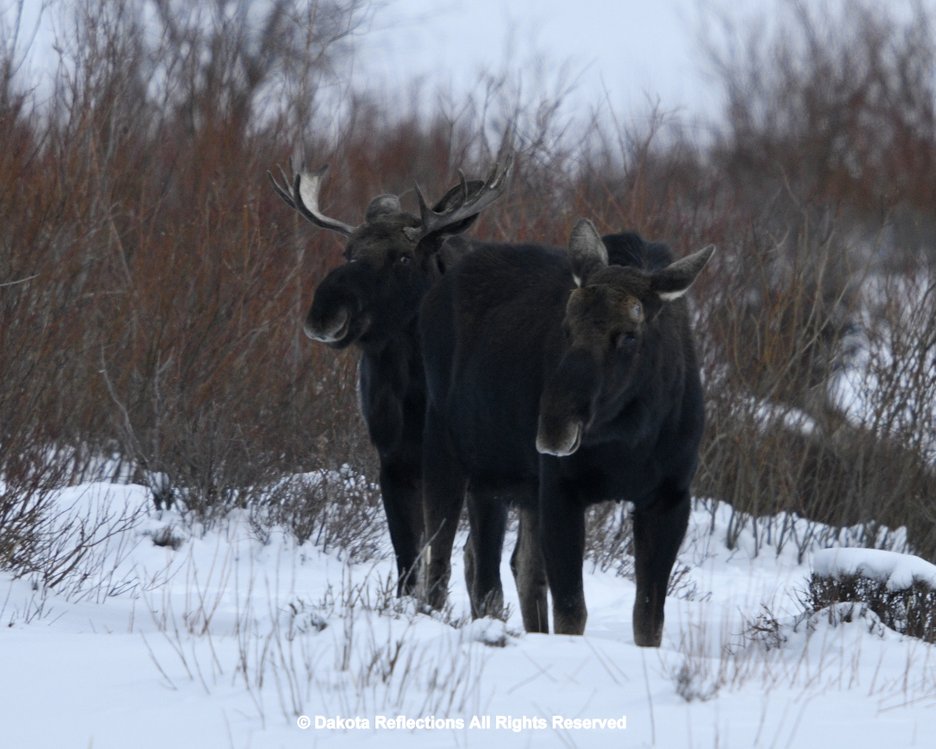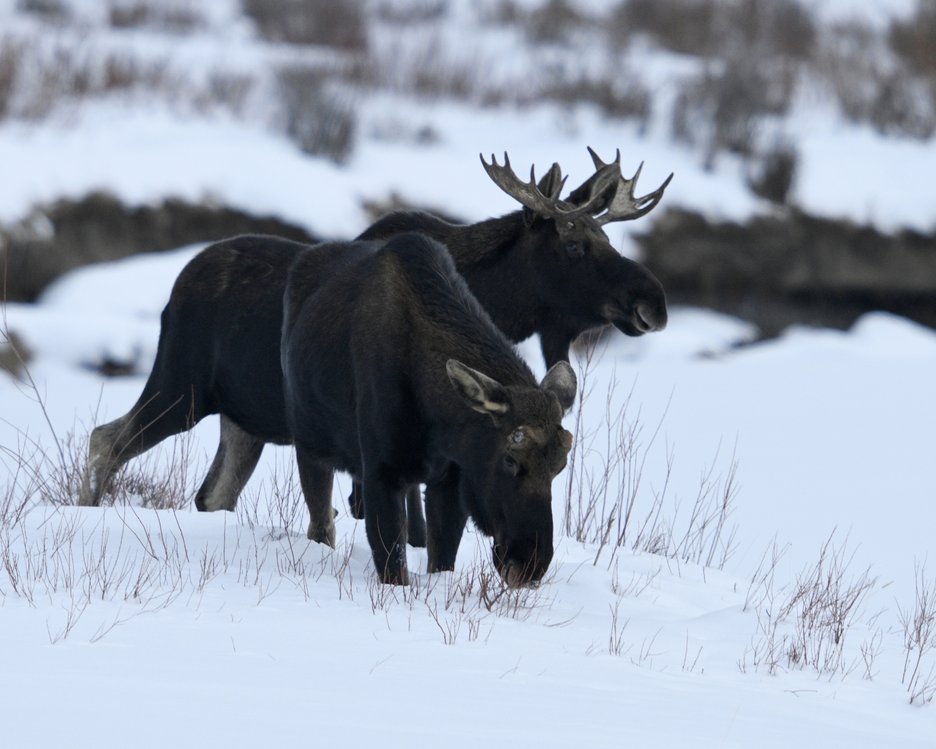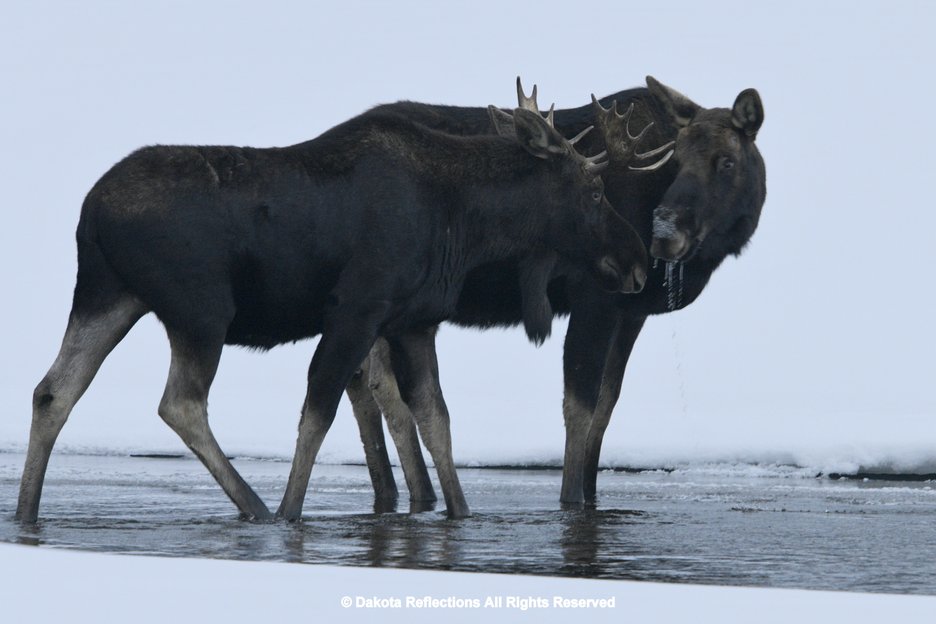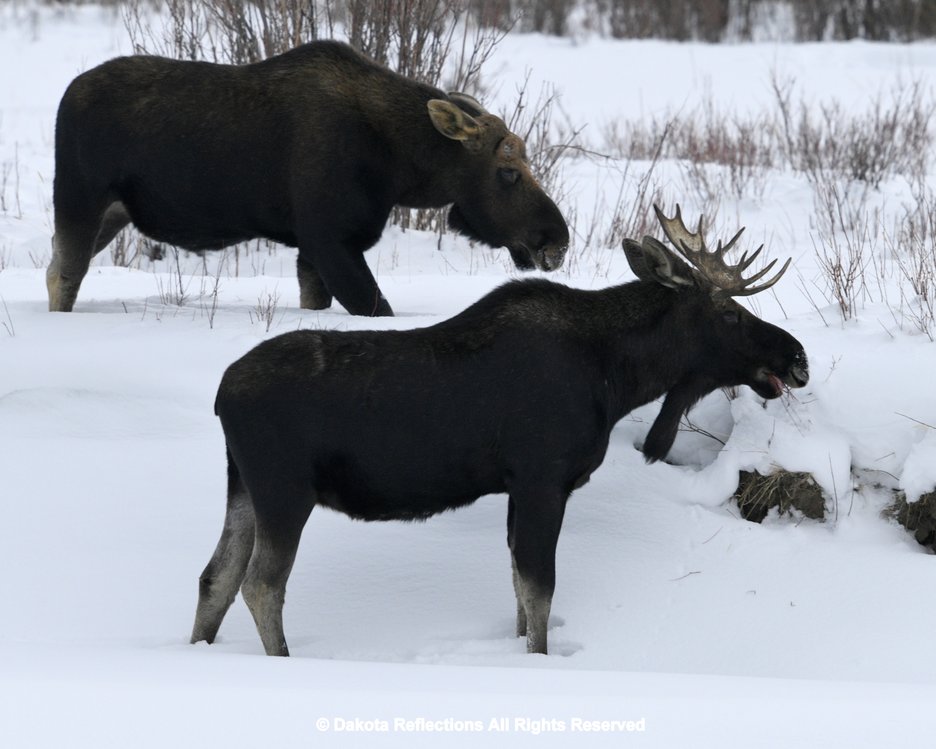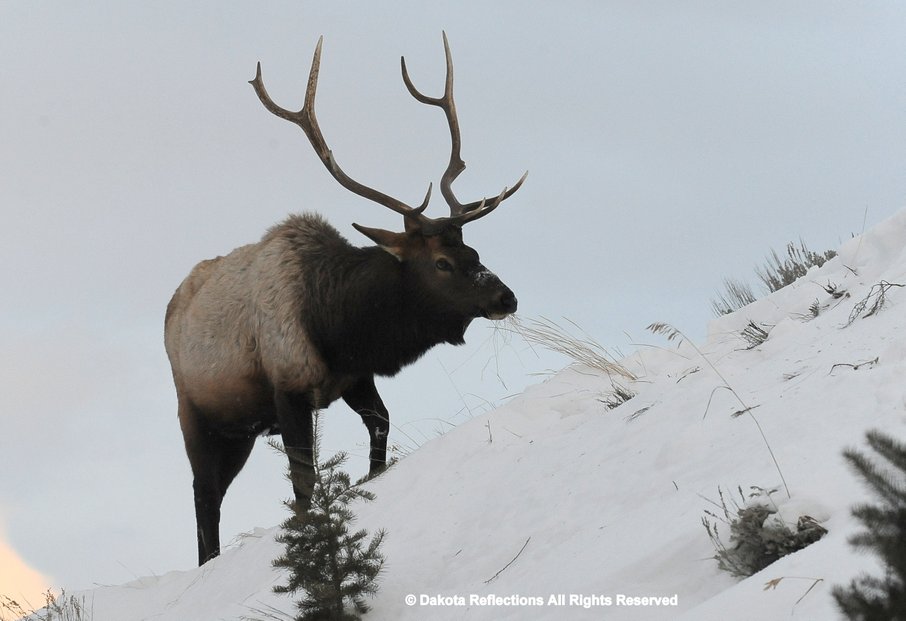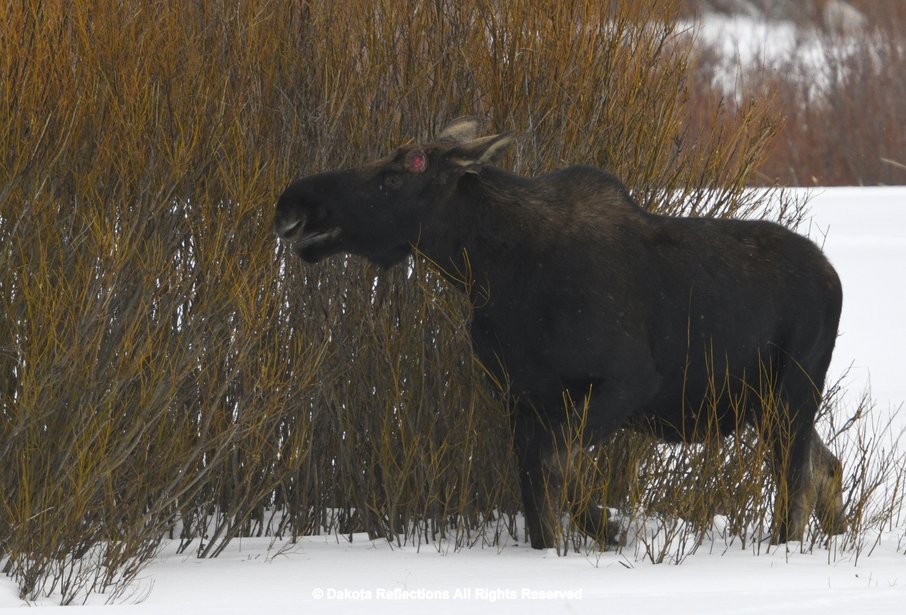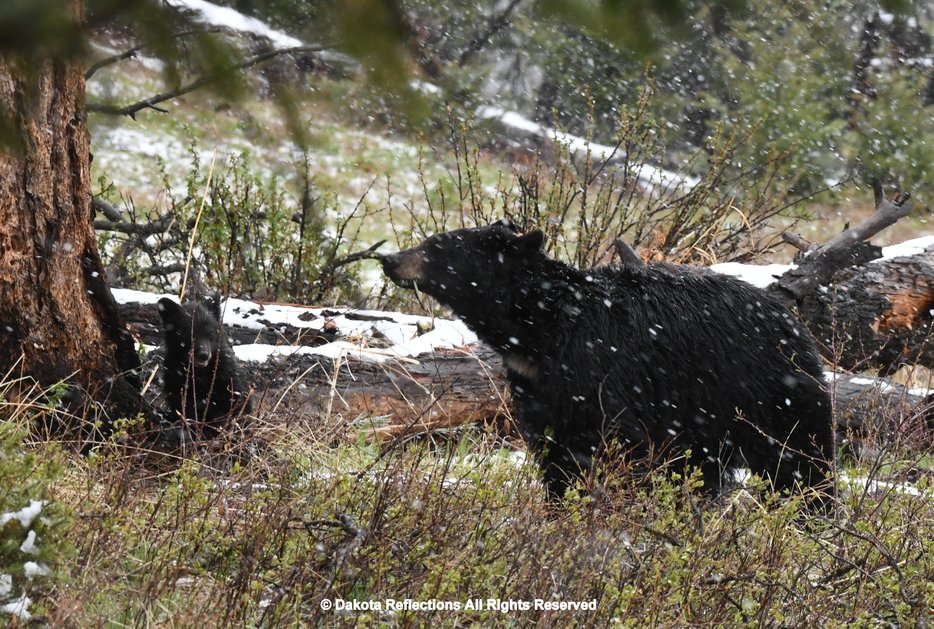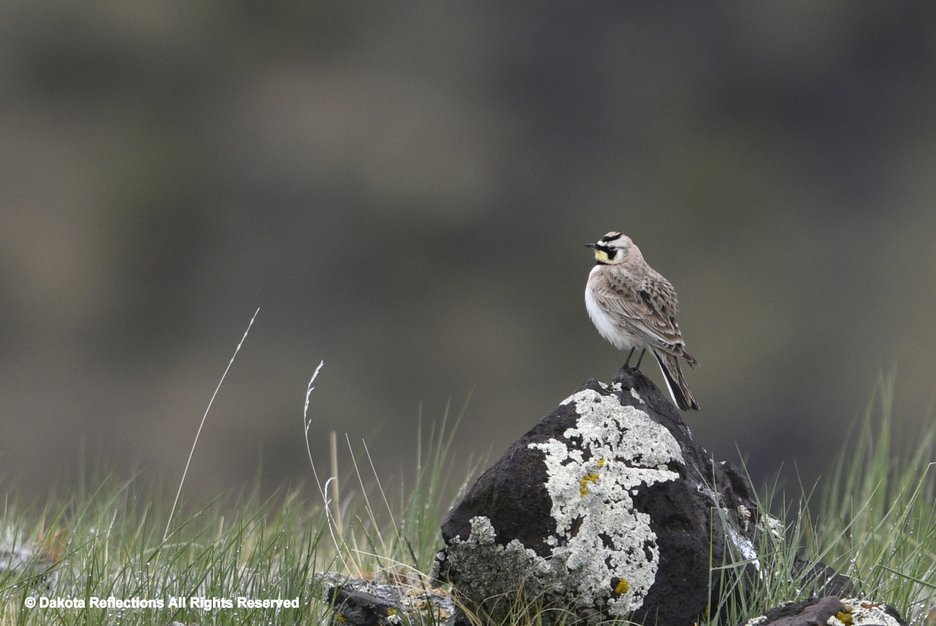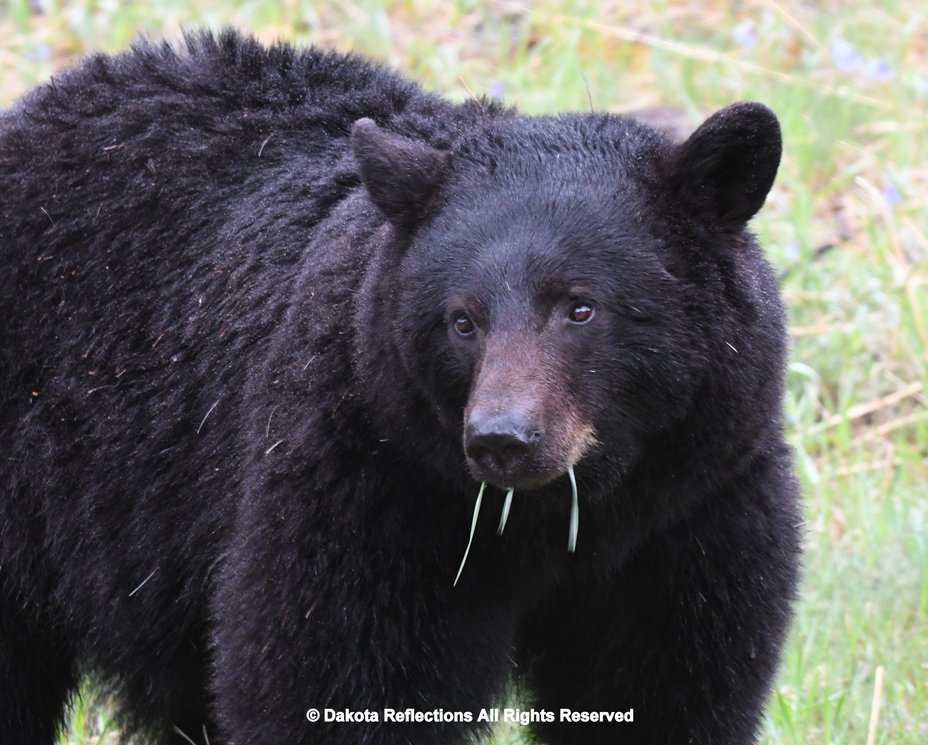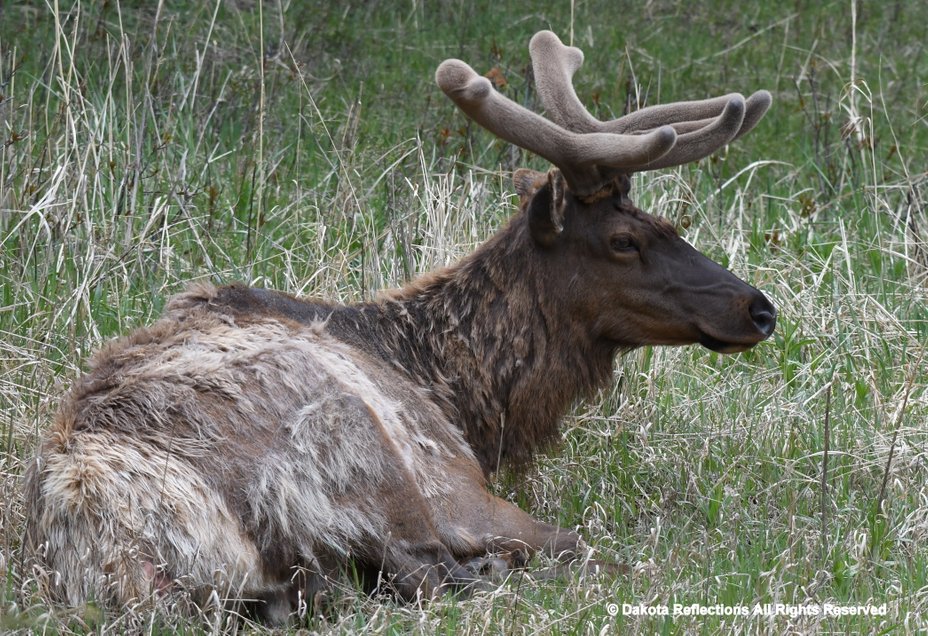Dakota Reflections
Yellowstone National Park is the oldested national park in the United States and the world, established in 1872 under President Grant.
The Park is very large with over 2 million acres, more than the combined size of Delaware and Rhode Island. In 2015, over 4 million visitors entered the park, most during the summer when some facilities were overwhelmed.
My favorite time to visit the park is during the winter, when animals are easier to see. However, in 2006, I participated in a week long wilderness canoe trip with youth to Shoshone Lake and had a great time. Shoshone Lake is the largest backcountry lake in the United States not accessible by road.
The park is home to one of the world's largest calderas with over 10,000 thermal features and more than 300 geysers. It has one of the world's largest petrifiied forests. It has nearly 300 waterfalls with the 300 foot Lower Falls of the Yellowstone River as the best known. Yellowstone Lake is the largest (132 sq. mi.) high altitude (7,732') lake in North America.
Yellowstone National Park
Bighorn Sheep
Yellowstone National Park
Wyoming
Coyote
Yellowstone National Park
Wyoming
Bighorn Sheep
Yellowstone National Park
Wyoming
Winter Landscape
Yellowstone National Park
Wyoming
Elk
Yellowstone National Park
Montana
Bighorn Sheep
Yellowstone National Park
Wyoming
Coyote
Yellowstone National Park
Wyoming
Winter Landscape
Yellowstone National Park
Wyoming
Winter 2019 Yellowstone
Junction Butte Wolf Pack of Eleven Attack Five Elk
The eleven member Junction Butte pack approached from the right, walking in line in the deep snow, conserving strength for the wolves following the leader.
As the pack got closer, the lead wolf branched up slope with six wolves following so they would be running down hill when they chased the elk, four of the wolves stayed on the original approach.
The five elk positioned themselves in a defensive position the the youngest (smaller antlers) in the center while the lead wolf approached the elk
The youngest elk panicked and left the group briefly while the older elk stood their ground. The young elk quickly returned to the other elk. The lead wolf's strategy to confront the youngest elk was temporarily successful.
Six wolves appproached from the left while five wolves stayed above and to the right of the elk. The perimeter to the right may have been composed of younger wolves who were observing the actions of their more senior pack members.
The elk were finally spooked and took off as a group with the majority of the wolf pack in pursuit.
The wolf perimeter collapsed as the elk ran down hill. One wolf got close the the elk who broke away from the other elk. The elk were able to escape!
It was 30 degrees below zero Fahrenheit the week I saw this bald eagle above the flowing Lamar River. Most bald eagles migrate out of Yellowstone Park during the winter but some stay year round. Open water means available fish.
The North American river otter lives in Yellowstone's rivers and lakes. They grow up to 4 feet long and can weigh up to 30 pounds. The can swim under water for up to 2 to 3 minutes.
Yellowstone National Park conducted a 5-year Yellowstone Raptor Initiative led by Doug Smith, a study designed to collect baseline data on golden eagles, red-tailed hawks and Swainson’s hawks with a lesser focus on American kestrels, prairie falcons and owls. That study ended in 2015. Considering the mountain habitat and high elevation of Yellowstone’s Northern Range, the region would appear to be marginal golden eagle habitat. They are more at home in the desert, grasslands or tundra — areas with wide swaths of open ground inhabited by rabbits, marmots, ground squirrels and other small mammals. Yet the raptor initiative found 28 golden eagle territories, the majority of them in the Northern Range — which is the area roughly between the North and Northeast entrances to Yellowstone. Golden eagles like to feed on wolve-killed elk remains.
https://billingsgazette.com/outdoors/yellowstone-s-golden-treasure-big-eagles-focus-of-recent-study/article_3be8a4ad-06b4-52f8-b1fe-03213fae2869.html
How Do Bison Survive Winter in Yellowstone National Park?
During the cold winter season, bison develop thick, woolly coats that help protect them from freezing temperatures and harsh winds. It is said that a bison's winter coat is so thick and provides insulation so effective that when snow accumulates on its coat, it will not melt from the heat of the bison's skin. Their skin also thickens in response to cold temperatures and fatty deposits appear to insulate the animal.
https://www.nps.gov/articles/bison-bellows-12-31-15.htm
Bison also have the ability use their large head and massive neck and shoulder muscles as snow plows to forage in snow as deep as four feet!
The reward for using their head as a snow plow is delicious brown and dry grass!
Bison use their tongue to keep their nostrils free of snow after snowplowing for grass!
Snowplow!
Snow Shower!
Year Round Water Bird
The Amercian Dipper inhabits the mountainous regions of Central America and western North America from Panama to Alaska and is equipped with an extra eyelid called a "nictitating membrane" that allows it to see underwater, and scales that close its nostrils when submerged. Dippers also produce more oil than most birds, which may help keep them warmer when seeking food underwater. The American dipper is usually a permanent resident, moving slightly south or to lower elevations if necessary to find food or unfrozen water. The presence of this indicator species shows good water quality; it has vanished from some locations due to pollution or increased silt load in streams. It feeds on aquatic insects and their larvae, including dragonfly nymphs, small crayfish, and caddisfly larvae. It may also take tiny fish or tadpoles.
https://en.wikipedia.org/wiki/American_dipper
Big Horned Sheep
About 10 to 13 interbreeding bands of bighorn sheep occupy steep terrain in the upper Yellowstone River drainage, including habitat that extends more than 20 miles north of the park. In 2015 , there were 329 in the northern Yellowstone area(163 counted inside the park).
https://www.nps.gov/yell/learn/nature/bighorn-sheep.htm
Bighorn sheep live in herds or bands of about 5 to 15 ewes, lambs, yearlings, and two-year olds. Groups of males are much smaller, usually numbering two to five. In the winter, the ewe herds join to create bands of as many as 100 animals.
https://defenders.org/bighorn-sheep/basic-facts
Two hundred years ago, bighorn sheep were widespread throughout the western United States, Canada, and northern Mexico. Some estimates placed their population at over 2 million. By around 1900, hunting, competition from ranching, and diseases had decreased the population to several thousand. A program of reintroductions, natural parks, and reduced hunting, together with a decrease in domesticated sheep near the end of World War II, allowed the bighorn sheep to make a comeback. An estimated 70,000 are now in North America.
https://en.wikipedia.org/wiki/Bighorn_sheep
https://www.bighorninstitute.org/bighorn-sheep-facts
As opposed to the American bison, who feed during the winter in deep valley snow, big horned sheep prefer steep windswept terraine where the snow is less deep and where the sheep can uncover vegetation by using their feet (hooves)
I liked this photograph for the shadow!
Head butting takes a toll on horns!
It is hard to believe that they can survive winter by eating dry grass but they do!
Little cutie with a frost head!
Exhaled air condenses at minus 30 degrees F!
Black-billed magpies are tolerated by big horned sheep as the birds will remove ticks and other skin parasites from the sheep!
Black-billed Magpies are social, inquisitive birds that eat fruits, grains, insects, small animals, and frequently gather in large flocks at carrion.
Coyotes watch for black-billed magpies to find carrion and magpies follow coyotes to eat left overs from a coyote kill
Not happy!
Snack time!
Keeping the nose clean!
Reaching for breakfast!
Lamar Buffalo Ranch
Moose
Approximately 200 moose are in Yellowstone National Park
Spring 2019
Time to go Fishing!
Mom Osprey, on the nest, was being vocal and perhaps giving instructions to Dad Osprey sitting on the branch. These ospreys were photogragh just before Lamar Valley in Yellowstone National Park
This lone Coyote was photogragh near the bridge over the Yellowstone River on Northeast Entrance Road in Yellowstone National Park
Baby Bison are called "Red Dogs" They are very active in the morning. Photograph was taken in Lamar Valley in Yellowstone National Park
Do you Want to Play?
Red Dogs are born in late April or early May in Yellowstone. Bison mate in August and September; gestation is 285 days. A single reddish-brown calf nurses until the next calf is born. If the cow is not pregnant, a calf will nurse for 18 months. Cows nurse their calves for at least 7 or 8 months, but most calves seem to be weaned before the end of their first year. At three years of age, bison cows are mature enough to produce a calf. Bison have a life expectancy around 15 years in the wild and up to 25 years in captivity.
https://en.wikipedia.org/wiki/American_bison
Peek a Boo Black Bear!
Black Bears are the most numerous members of the bear family in North America, and are found from the Pacific to the Atlantic coast. There are an estimated 500-600 black bears inhabiting Yellowstone National Park.
https://yellowstone.net/wildlife/black-bears
Black Bears are very fast and can run up to 30 mph. They are also excellent at quickly climbing and descending trees which I witnessed several times in Yellowstone National Park.
Up to 85% of the American black bear's diet consists of vegetation, though they tend to dig less than brown bears, eating far fewer roots, bulbs, corms and tubers than the latter species. When initially emerging from hibernation, they will seek to feed on carrion from winter-killed animals and newborn ungulates. As the spring temperature warms, American black bears seek new shoots of many plant species, especially new grasses, wetland plants and forbs. Young shoots and buds from trees and shrubs during the spring period are also especially important to American black bears emerging from hibernation, as they assist in rebuilding muscle and strengthening the skeleton and are often the only digestible foods available at that time. During summer, the diet largely comprises fruits, especially berries. During the autumn hyperphagia, feeding becomes virtually the full-time task of American black bears. Favored masts such as hazelnuts, oak acorns and whitebark pine nuts may be consumed by the hundreds each day by a single American black bear during the fall. During the fall period, American black bears may also habitually raid the nut caches of tree squirrels. Also extremely important in fall are berries such as huckleberries and buffalo berries.
https://en.wikipedia.org/wiki/American_black_bear
The black bear has a straight face when seen in profile. Its eyes are small and the ears are well-rounded. It has 42 teeth: 12 incisors, 4 canines, 16 premolars and 10 molars. The canines are long and well pointed; the premolars are rudimentary or even missing; and the molars have flat crowns. People have 32 teeth.
http://www.bebearaware.org/Bears_of_North_America/bears_of_north_america.html
The chipping sparrow is a species of American sparrow, a passerine bird in the family Passerellidae. It is widespread, fairly tame, and common across most of its North American range. There are two subspecies, the eastern chipping sparrow and the western chipping sparrow. This bird is a partial migrant with northerly populations flying southwards in the fall to overwinter in Mexico and the southern United States, and flying northward again in spring.
https://en.wikipedia.org/wiki/Chipping_sparrow
Yellow-rumped warblers spend the breeding season in mature coniferous and mixed coniferous-deciduous woodlands (such as in patches of aspen, birch, or willow). In the western U.S. and in the central Appalachian Mountains, they are found mostly in mountainous areas.
https://en.wikipedia.org/wiki/Yellow-rumped_warbler
Coyote eating snake near Tower Falls. The coyote did not appear to enjoy the meal.
Coyote removing snake smell from nose.
Pikas are 7–8.4 in. long, 5.3–6.2 ounces (about the size of a guinea pig); Active year-round; agilely darts around on rocks; travels through tunnels under snow; Breed in spring; two litters per year; Often heard but not seen; makes a distinct shrill whistle call or a short “mew.”; Grey to brown with round ears, no tail. Blends in with rocks; Scent marks by frequently rubbing cheeks on rocks; In late summer it gathers mouthfuls of vegetation to build “haystacks” for winter food; defends haystacks vigorously; Haystacks often built in same place year after year; have been known to become three feet in diameter.
https://www.nps.gov/yell/learn/nature/pika.htm
What a Wonderful Mom!
I was over 100 yards away from this Grizzly Bear Mom nursing her two cubs in Yellowstone National Park. Grizzly Bear Moms will nurse her cubs for over 2 years, all the time protecting them from other bears.
Baby has an Itch!
Mom Can Stretch while Nursing!
Babies Love to Play!
Harlequin Duck
Their breeding habitat is cold fast-moving streams in north-western and north-eastern North America, Greenland, Iceland and eastern Russia. The nest is usually located in a well-concealed location on the ground near a stream. They are usually found near pounding surf and white water. They are short distance migrants and most winter near rocky shorelines on the Atlantic and Pacific coasts. They are very rare migrants to western Europe.
https://en.wikipedia.org/wiki/Harlequin_duck
The Ruffed Grouse is a medium-sized grouse occurring in forests from the Appalachian Mountains across Canada to Alaska. It is non-migratory. The ruffed grouse is sometimes incorrectly referred to as a "partridge", and occasionally confused with the grey partridge, a bird of open areas rather than woodlands. The ruffed grouse is the state bird of Pennsylvania, United States.
https://en.wikipedia.org/wiki/Ruffed_grouse
The ruffs are on the sides of the neck in both sexes. They also have a crest on top of their head, which sometimes lies flat. Both genders are similarly marked and sized, making them difficult to tell apart, even in hand. The female often has a broken subterminal tail band, while males tend to have unbroken tail bands, though the opposite of either can occur. Females may also do a display similar to the male. Another fairly accurate sign is that rump feathers with a single white dot indicate a female; rump feathers with more than one white dot indicate a male.
https://en.wikipedia.org/wiki/Ruffed_grouse
This black bear was photographed on May 29, 2019 in Yellowstone National Park in evening light.
The Black Bear stayed in the clearing for a few minutes before returning to the woods.
Elk in Velvet
Sandhill Crane Adventures
May 30, 2019
"It sure is hard to climb on Mom's back!"
"Almost There!"
"Almost There!"
"Almost There!"
"Oh, That was too Tough. I Think I will Sleep Next to Mom- I Can Hear Her Heartbeat- My Favorite Sound!"
Sandhill cranes raise one brood per year. In nonmigratory populations, laying begins between December and August. In migratory populations, laying usually begins in April or May. Both members of a breeding pair build the nest using plant material from the surrounding area. Nest sites are usually marshes, bogs, or swales, though occasionally on dry land. Females lay one to three (usually two) oval, dull brown eggs with reddish markings. Both parents incubate the eggs for about 30 days. The chicks are precocial; they hatch covered in down, with their eyes open, and able to leave the nest within a day. The parents brood the chicks for up to three weeks after hatching, feeding them intensively for the first few weeks, then gradually less frequently until they reach independence at 9 to 10 months old. The chicks remain with their parents until one to two months before the parents lay the next clutch of eggs the following year, remaining with them 10–12 months. After leaving their parents, the chicks form nomadic flocks with other juveniles and nonbreeders. They remain in these flocks until they form breeding pairs at between two and seven years old.
https://en.wikipedia.org/wiki/Sandhill_crane
May 31, 2019
Oops! Baby on right fell down walking through mud holes. Baby on left is being fed by Mom!
Sandhill Crane Family!
The Bison and the Sandhill Crane Family!
June 2, 2019
After finding the baby Sandhill Cranes on May 30, 2019 I was able to watch them for 4 days. The Yellowstone National Park Staff stated that they had been born on May 29. By the 3rd day, the babies were following their parents up the grassy slopes so their parents could feed them insects. On the evening of June 2, the Crane family was returning to the slough where their nest was located. Three large American Bison were also feeding near the slough and one Bison approached where the Cranes were!
As the Bison got within a couple of yards of the babies, they hide in the slough grass and Sandhill Crane Mom walked to within a few feet of the Bison, calling loudly!
Sandhill cranes defend themselves and their young from aerial predators by jumping and kicking. Actively brooding adults are more likely to react aggressively to potential predators to defend their chicks than wintering birds, which most often normally try to evade attacks on foot or in flight. For land predators, they move forward, often hissing, with their wings open and bills pointed. If the predator persists, the crane stabs with its bill (which is powerful enough to pierce the skull of a small carnivore) and kicks.
https://en.wikipedia.org/wiki/Sandhill_crane
"Stay Away from My Babies"
The 9-pound Sandhill Crane Mom did not strike or kick at the Bison, loud calling and sudden flapping of wings was enough to startle the 2000-pound Bison.
"Stay Away from My Babies"
This is the first time that I have seen a Bison jump away from another animal!
"Stay Away from My Babies"
The 2000-pound Bison wanted nothing to do with an upset 9-pound Sandhill Crane Mom.
"You Stay Away from My Babies and Don't Come Back"
The Bison did just that and mom returned to her babies.
The Bison was relieved that the whole situation was over.
American Badger- Battles and Hunting
Badgers are usually solitary in their habits. The badger on the left apparently encroached on the territory of the badger on the right. I just come up on this situation and barely had time to get my camera on the tripod when the chase ensued.
I am not sure how this ended as the Badgers went over a hill. The badger on the right appeared to be larger but with tail down while the badger on the left had tail up. The badger on the left may have been defending its territory.
How do Badgers Hunt Ground Squirrels?
Hunting Techniques and Tool Use by North American Badgers Preying on Richardson's Ground Squirrels
Abstract
Techniques used by North American badgers (Taxidea taxus) when hunting Richardson's ground squirrels (Spermophilus richardsonii) were assessed over a 15-year period in southern Alberta to determine the relationship between activity of prey and methods used to capture prey. Badgers frequently hunted hibernating squirrels in autumn, sometimes hunted infants in spring, and rarely hunted active squirrels in summer. Badgers always captured hibernating squirrels and infants underground, usually captured active squirrels underground, and sometimes intercepted fleeing squirrels aboveground. Regardless of season or year, the most common hunting technique used by badgers was excavation of burrow systems, but plugging of openings into ground-squirrel tunnels accounted for 5–23% of hunting actions in 4 consecutive years. Plugging occurred predominantly in mid-June to late July before most ground squirrels hibernated and in late August to late October when juvenile males were active but other squirrels were in hibernation. Badgers usually used soil from around the tunnel opening or soil dragged 30–270 cm from a nearby mound (72% and 22% of 391 plugged tunnels, respectively) to plug tunnels. The least common (6%), but most novel, form of plugging used by 1 badger involved movement of 37 objects from distances of 20–105 cm to plug openings into 23 ground-squirrel tunnels on 14 nights. Aimed movement of objects to plug openings into burrow systems occupied by ground squirrels qualified this badger as a tool user.
Michener, GM. Journal of Mammalogy, Volume 85, Issue 5, 20 October 2004, Pages 1019–1027
On June 1, 2019, I observed an American Badger for 10 minutes as it used its brains, experience, sense of small and digging ability to hunt a Unita Ground Squirrel.
The Badger indentified two holes to dig out and used its sense of smell to determine which ones to dig. The badger's sense of smell is very powerful and they can detect an animal in its burrow through soil as well as snow cover.
https://www.animalfactsencyclopedia.com/Badger-facts.html
The Badger is always on the look out, even when busy hunting and digging.
The Badger's nose was dirty with all that digging.
The Badger's vigorous shaking removed the dirt only to get dirting again from more digging.
The Badger was digging in two holes- would dig one hole for a while, come out, sniff, then go dig further in the other hole.
The Badger then stood up in the hole on the left and used its rear legs and paws to trample down the dirt, blocking the hole.
The Badger went down the hole on the right, came up and stood still for a few seconds then began to sniff around a nearby small shrub. The Badger appeared to be frustrated.
The Badger had found a second escape hole for the Ground Squirrel which had been cleverly placed near a low shrub making it difficult for the Badger to get to. The Badger then crawled under the shrub.
The Badger then lifted up the shrub with its back whick allowed it enough room to dig down the hole before plugging it up.
The Badger then went down what was then the center hole and was down there for about 1 to 2 minutes.
The Badger emerged with a Ground Squirrel and quickly moved away and disappeared among the small shrubs. The Badger had a strategy in going after the Ground Squirrel- it used its sense of smell to figure out which holes to dig out. The Badger plugged two escape holes using a digging and stamping approach. The Badger overcame an escape hole under a shrub that was difficult to plug and was rewarded with a meal.
Pronghorn have two sets of teeth- front incisors cut the vegetation while the back molars chew and grind food- 32 teeth total.
Black Bear May 30, 2019.
About 800 moose inhabit the southern part of Yellowstone, Grand Teton National Park and surrounding national forests.
https://www.yellowstonepark.com/things-to-do/about-moose
This largest member of the deer family loves cold weather and frequents marshy meadows and edges of lakes and streams
https://www.yellowstonepark.com/things-to-do/about-moose
Newborn moose have fur with a reddish hue in contrast to the brown appearance of an adult. The young will stay with the mother until just before the next young are born.
https://en.wikipedia.org/wiki/Moose
Female moose have an eight-month gestation period, usually bearing one calf, or twins if food is plentiful, in May or June. Twinning can run as high as 30% to 40% with good nutrition.
https://en.wikipedia.org/wiki/Moose
Moose, which are called elk in Europe, are well-known for their impressive hearing. Their ears are more than 60 times larger than those of a human, and their calls can travel nearly two miles.
https://www.theguardian.com/science/2008/mar/21/medicalresearch.animalbehaviour
Moose are the largest members of the deer family, weighing as much as 1200 pounds; they can grow to be 5 to 6.5 feet from hooves to shoulders. This does not include a raised head or antlers, so it's safe to say that the majority of moose tower over all non-basketball players.
http://mentalfloss.com/article/59461/10-gigantic-facts-about-moose
The Cinnamon Bear is both a highly variable color morph and a subspecies of the American black bear, native to the central and western areas of the United States and Canada. Established populations are found in Colorado, New Mexico, Utah, Idaho, Montana, Washington, Manitoba, Minnesota, Wisconsin, Wyoming, California, Alberta, Ontario and British Columbia. They also have been seen in Pennsylvania and New York. The most striking difference between a cinnamon bear and any other black bear is its brown or red-brown fur, reminiscent of cinnamon.
https://en.wikipedia.org/wiki/Cinnamon_bear
This Big Horned Sheep was photographed north of Lamar Buffalo Ranch on a walk to see the historic wolf pens.
American Cliff Swallows are extremely social song birds that can be found in large nesting colonies reaching over 2,000 nests. They are frequently seen flying overhead in large flocks during migration, gracefully foraging over fields for flying insects or perching tightly together on a wire preening under the sun. Cliff swallows build gourd-shaped nests made from mud with small entrance holes. They build their nests tightly together, on top of one another, under bridges or alongside mountain cliffs. Living in large populations, these aerial insectivores use extensive vocalizations to communicate warnings or food availability to the other individuals.
https://en.wikipedia.org/wiki/American_cliff_swallow
American yellow warblers breed in most of North America from the tundra southwards, except for the far Southwest and the Gulf of Mexico coast.[4] American yellow warblers winter to the south of their breeding range, from southern California to the Amazon region, Bolivia and Peru. As usual for members of the Parulidae, yellow warblers nest in trees, building a small but very sturdy cup nest. Females and males rear the young about equally, but emphasize different tasks: females are more involved with building and maintaining the nest, and incubating and brooding the offspring. Males are more involved in guarding the nest site and procuring food, bringing it to the nest and passing it to the waiting mother, which does most of the actual feeding. As the young approach fledging, the male's workload becomes proportionally higher'
https://en.wikipedia.org/wiki/American_yellow_warbler
2020 Yellowstone Photographs
Sunbathing!
Goldeneyes!
Mom and daughter!
I snowshoed 100 yards in snow 3 feet deep to photograph this mom (cow) and baby (calf) in Yellowstone National Park! Female calves stay with their moms for 2 years and after leaving often stay nearby. Male calves usually leave at 1 1/2 years of age.
Mom eats tall willow branches, saving lower ones for baby!
Mom ate the tall branches, saving the lower ones for her second year daughter.
Photo of the Day for January 19, 2020
Bull Moose in Very Deep Snow!
Not the best photo due to branches and shrubs in the way but it does show the "Moose Dance" as he decided to prance in the deep snow!
Winter Sunrise- Lamar Valley with Fog in the Valley!
Lamar Buffalo Ranch with Winter Frost!
Getting a Drink is Better than Eating Snow!
Bison Snowplow!
Ermine
Ermine
At full adult size total body length from head to rump is 170 mm to 330 mm. Males are generally twice as large as females, with males weighing from 67 to 116 grams and females from 25 to 80 grams. The tail length is about 35% of the total body length, ranging from 42mm to 120mm. Ermine have the typical weasel form: long body, short legs, long neck supporting a triangular head, slightly protruding round ears, bright black eyes, and long whiskers.
Their short, moderately fine fur is white in the winter and the tip of the tail is black. In the summer, the fur on the back is chocolate brown while the fur on the belly extending to the upper lip is yellowish white. Ermine are distributed all the way around northern part of the globe. They are found in the north temperate regions of Eurasia and North America. In the New World, they range from east to west in a broad belt from the Arctic Ocean and adjacent islands of the Canadian Archipelago southward into the northern United States. Ermine are absent from the Great Plains. Ermine prefer woodlands near rivers, marshes, shrubby fencerows, and open areas adjacent to forests or shrub borders. Although ermine live primarily on the ground, they climb trees and swim well.
Tree roots, hollow logs, stone walls, and rodent burrows are used as dens. Dens are usually around 300 mm below ground. Ermine line their nests with dry plant material, and fur and feathers from prey. Side cavities of burrows are used for storing food and as bathrooms. Ermine mate in late spring to early summer. Females produce only 1 litter per year. Young are born in April or May after an average pregnancy of 280 days, which includes an 8 to 9 month period in which the young do not develop. Longer days beginning in March trigger the young to begin developing. Litter size ranges from 3 to 18 offspring and averages 4 to 9. Young are blind and helpless. They are covered with fine white hair, and a prominent dark mane of dense fur develops around the neck by the third week (function unknown). The young grow quickly and are able to hunt with their mother by their eighth week. Although females do not reach adult size until a least 6 weeks after birth, they are able to mate when they are 60 to 70 days old, often before they are weaned. Males do not breed or grow to adult size until their second summer.
Females in nature may survive for at least 2 breeding seasons, while males generally do not survive this long. The number of offspring that each ermine has in its lifetime depends on the amount of food that is available.
The ermine's slender, agile body allows it to move swiftly both above ground and through underground burrows. Females hunt in tunnels more than males, which may explain the higher number of males that are trapped. Ermine can also run easily across snow. This ideal predator hunts in a zigzag pattern, moving by a series of leaps of up to 50 cm each. Ermine investigate every hole and crevice, often stopping to survey their surroundings by raising their heads and standing upright on their hindlegs. They may travel up to 15 km in one night.
Adult males dominate females and young. Females tend to remain in their birth place throughout their lives. Males spread out and claim large territories that usually contain or overlap females' territories. Male and female ermine only associate with one another during the breeding season.
Ermine territories change size with prey abundance. The maximum home range size is about 20 hectares (0.2 square kilometers). When there is a lot of food, individuals don't need to travel as far to hunt and can live in smaller areas of about 10 hectares (0.1 square kilometers). Home ranges of males are usually twice the size of female home ranges. These solitary mammals keep others out by patrolling their territory boundaries and marking them with scent.
Ermine have keen senses of smell, vision, hearing, and touch that help them to locate prey. Most members of the weasel family are fairly quiet animals, but some vocalizations may be used for communication. Ermine probably use odor to let other ermine know they are ready to mate.
Ermine are carnivores that hunt mostly at night. They are predators on small, warm-blooded vertebrates, preferably mammals of rabbit size and smaller. When mammalian prey is scarce, ermine eat birds, eggs, frogs, fish, and insects. In severe climates, ermine often hunt under snow and survive entirely on small rodents and lemmings. Ermine must eat daily to meet their high energy demands. They store leftover meals as a way of dealing with these demands.
When an ermine senses a prey animal, it approaches as closely as possible. With incredible speed it grasps the back of the victim's head and neck with sharp teeth, and wraps its body and feet around the victim. The victim dies from repeated bites to the base of the skull. Ermine have keen senses that help them locate prey. Hares and rodents are mainly followed by scent, insects by sound, and fish by sight.
http://www.biokids.umich.edu/critters/Mustela_erminea/
Bighorn sheep have rubber-like hooves that help them walk on steep rock faces. They also use their hooves to clear snow from the ground.
So they can find grass to eat!
Several raven relatives live in Yellowstone, including the common raven (Corvus corax). Common ravens are smart birds, able to put together cause and effect. Ravens are attracted to wolf kills and may follow wolves while they hunt elk. Wolves also provide better access to carrion, as ravens are not able to rip open thick skin on their own. Ravens are willing to eat almost anything and are frequently seen near parking lots searching for food—some have even learned to unzip and unsnap packs. Recent surveys indicate 200–300 ravens are present in the northern range of Yellowstone and 53% of those are in wolf habitat, away from human areas. Before wolf reintroduction, nearly 74% of ravens likely used human areas. Researchers are further investigating seasonal and spatial patterns in raven habitat use, and their relationships with humans and wolves, by monitoring raven movements using satellite transmitters.
https://www.nps.gov/yell/learn/nature/raven.htm
This American bald eagle was perched near the confluence of Soda Butte Creek and the Lamar River as I was heading back from my all too short trip to Yellowstone National Park in January 2020!
Enjoying and evening meal!
This big guy recently dropped his antlers!
Just a little too far away for a decent photograph. Perhaps next year I can photograph a red fox catching a mouse!
2021 Yellowstone Photographs
Moose
Yellowstone National Park
January 29, 2021
Moose
Yellowstone National Park
January 29, 2021
Common Goldeneye
Yellowstone National Park
January 29, 2021
Barrow's and Common Goldeneye
Yellowstone National Park
January 31, 2021
Barrow's and Common Goldeneyes
Yellowstone National Park
January 31, 2021
Common Goldeneyes
Yellowstone National Park
February 2, 2021
Common Goldeneyes
Yellowstone National Park
February 2, 2021
Common Goldeneye
Yellowstone National Park
February 2, 2021
Common Goldeneye
Yellowstone National Park
February 2, 2021
Common Goldeneye
Yellowstone National Park
February 2, 2021
Fighting over Breakfast of Common Goldeneye!
Golden Eagles
Yellowstone National Park
January 29, 2021
This Golden Eagle flew right over my vehicle and landed 20 yards away, wearing a transmitter!
Golden Eagle
Yellowstone National Park
January 29, 2021
AIR SUPPORT: YELLOWSTONE’S GOLDEN EAGLE STUDY
MAY 3, 2018
PRESERVING THE PARK, RAPTORS, WILDLIFE
This article first appeared in the Fall 2017 issue of Yellowstone Quarterly.
“Golden eagles are North America’s largest bird of prey, so why do we know so little about them?” asks Doug Smith, a senior wildlife biologist at Yellowstone National Park. To answer this question, Smith heads up the Yellowstone Golden Eagle Study, a scientific examination that monitors the population, breeding, and behavior of these magnificent birds in the park.
This investigation is an outgrowth of the five-year Yellowstone Raptor Initiative, which began in 2011 with a grant from the Yellowstone Park Foundation and focused on studying the more than 20 species of raptors that call the park home. “Before the Yellowstone Park Foundation funded our initial study, the park was only monitoring three raptor species—peregrine falcons, bald eagles, and ospreys,” notes Smith. “After five years of research, we concluded there was a scientific oversight in terms of understanding golden eagle ecology, and determined there should be long-term monitoring of the species given the critical role they play in the functioning of an avian ecosystem.”
Contributing to this need for further study is a 2016 U.S. Fish and Wildlife Service study that denoted the golden eagle population as “stable,” but also observed: “the population in the coterminous western U.S. [from the 100th meridian to the Pacific Ocean] might be declining towards a lower equilibrium size.”
There are many factors that could be contributing to the birds’ population decline, with everything from habitat loss, lead poisoning from scavenging on hunters’ kills, and high-speed wind turbines placed in ideal eagle environments playing a role. With such a large area to cover, some places have reported that the birds are doing well, and others have found cause for concern.
Researcher preparing to place a remote camera in an empty golden eagle nest.
The folks in Yellowstone realized that they had little data to contribute to the conversation. “When we discovered U.S. Fish and Wildlife was trying to determine the status of golden eagles throughout the West, we found out we knew little or no information about the birds in the Greater Yellowstone Ecosystem,” Smith says. “We thought we better learn more.” Enter Yellowstone Forever. Since the Yellowstone Park Foundation already sponsored the previous raptor study, Yellowstone Forever was poised to fund a continuation of the project. “Though the first go-round was a tremendous success, at the conclusion of the initial five years we knew there were still a lot of questions to be answered, especially about the golden eagles and the significant role they play in the ecosystem,” says Jeff Augustin, Yellowstone Forever’s senior director of park projects. “That’s why,” Augustin adds, “when it was over and the park submitted a list of the projects for funding that they deemed priorities, we were excited to see the golden eagle study on there.” Soon after, Yellowstone Forever secured gifts from individuals and foundations to fully fund the program for three years.
Smith classifies this extra time to study golden eagles as a “godsend.” That’s because so far the park’s monitoring has turned up some thought-provoking data that needs to be looked at closer. Thanks to the previous years of field work, which included countless miles of hiking in the backcountry to spot the birds and track them to their nests, researchers now know that Yellowstone is home to 28 golden eagle territories, each of which corresponds to a nested pair. (Golden eagles are very territorial and will dive bomb interlopers to defend their home range.) Twenty-one of these nesting areas are in the northern part of the park where the habitat—semi-open country, high-altitude mountains, and cliffsides—is more suitable to the birds.
According to Smith, what’s interesting about the golden eagles in Yellowstone is that their numbers and breeding habits don’t match up—the birds’ population density is quite high, but their productivity when it comes to producing offspring is very low. “We are focused right now on trying to figure why the eagles are doing so well but also why there are so few young.” Adding to the intrigue is that other studies have shown that golden eagles in the Livingston and Cody areas produce a lot of young.
Smith is exploring two key factors as to whether or not young golden eagles survive: the severity of winter weather and the levels of spring precipitation. It is possible that heavy snow years mean more winter kills and more wolf kills, which in turn creates an abundance of food for eagles to scavenge and allows the birds to build up strength for the upcoming breeding season. But a cold and wet spring could cause problems with nesting, resulting in young that fail to survive.
“To study how the weather affects these birds we really need to see a variation of conditions for an extended time so that we can overlay the breeding and meteorological data for accurate results,” Smith says. “That’s why Yellowstone Forever continuing to fund this study is so important—the more years we study, the more reliable our findings will be.” Along with determining whether or not Yellowstone is a stronghold for these raptors, Smith believes the study will help place the golden eagle in the same conversation with Yellowstone’s most famous fauna—bears, bison, and wolves.
“These birds are grand, majestic animals. We’ve found 10–12 species of animals in golden eagles’ nests, everything from rabbits to pronghorn fawns. Golden eagles are every bit the predator as Yellowstone’s big carnivores,” Smith says. “They are the wolves of the sky and are deserving of the attention we and the public have given to Yellowstone’s other iconic wildlife.”
https://www.yellowstone.org/air-support-yellowstones-golden-eagle-study/?gclid=Cj0KCQiAgomBBhDXARIsAFNyUqM_xonPtonxOcfsVz0GQ4Vn9gu_9A2noludlb4mSwz2_C-AufzTFiQaAjBOEALw_wcB
Closeup!
Golden Eagle
Yellowstone National Park
January 29, 2021
Impressive!
Golden Eagle
Yellowstone National Park
January 29, 2021
Magnificent!
Golden Eagle
Yellowstone National Park
Photo of the Day- January 29, 2021
American Bald Eagle
Yellowstone National Park
January 30, 2021
American Bald Eagle
Yellowstone National Park
January 30, 2021
American Bald Eagle
Yellowstone National Park
January 30, 2021
American Bald Eagle
Yellowstone National Park
Photo of the Day- January 30, 2021
American Bison
Yellowstone National Park
January 30, 2021
American Bison
Yellowstone National Park
January 31, 2021
American Bison
Yellowstone National Park
January 31, 2021
American Bison
Yellowstone National Park
January 31, 2021
Coyote on Remains of Canada Goose
Yellowstone National Park
January 31, 2021
Coyote
Yellowstone National Park
February 1, 2021
Coyote
Yellowstone National Park
February 1, 2021
Coyote
Yellowstone National Park
February 1, 2021
Coyote
Yellowstone National Park
February 2, 2021
Coyote
Yellowstone National Park
February 2, 2021
River Otter
Yellowstone National Park
January 31, 2021
River Otter
Yellowstone National Park
January 31, 2021
River Otter
Yellowstone National Park
January 31, 2021
River Otter
Yellowstone National Park
February 2, 2021
River Otter
Yellowstone National Park
February 2, 2021
River Otter
Yellowstone National Park
February 2, 2021
Snowscape
Yellowstone National Park
January 31, 2021
Madison River
Yellowstone National Park
February 1, 2021
Madison River
Yellowstone National Park
February 1, 2021
Old Faithful
Yellowstone National Park
February 1, 2021
Old Faithful
Yellowstone National Park
February 1, 2021
Trumpeter Swans
Yellowstone National Park
February 1, 2021
Trumpeter Swans
Yellowstone National Park
February 1, 2021
Trumpeter Swans
Yellowstone National Park
February 1, 2021
Trumpeter Swans
Yellowstone National Park
February 1, 2021
Trumpeter Swans
Yellowstone National Park
February 1, 2021
American Dipper
Yellowstone National Park
February 2, 2021
Mule Deer
Yellowstone National Park
Photo of the Day- February 3, 2021
Mule Deer
Yellowstone National Park
February 3, 2021
Sunset
Yellowstone National Park
February 3, 2021
Black Bear
Yellowstone National Park
May 21, 2021
Black Bear
Yellowstone National Park
May 21, 2021
Chipping Sparrow
Yellowstone National Park
May 21, 2021
Mountain Bluebird
Yellowstone National Park
May 21, 2021
Mountain Bluebird
Yellowstone National Park
May 21, 2021
Mountain Bluebird
Yellowstone National Park
May 21, 2021
Mountain Bluebird
Yellowstone National Park
May 21, 2021
Mountain Bluebird
Yellowstone National Park
May 21, 2021
Mountain Bluebird
Yellowstone National Park
May 21, 2021
Western Meadowlark
Yellowstone National Park
May 21, 2021
Yellow-rumped Warbler
Yellowstone National Park
May 21, 2021
Yellow-rumped Warbler
Yellowstone National Park
May 21, 2021
Yellow-rumped Warbler
Yellowstone National Park
May 21, 2021
Bighorn Sheep
Yellowstone National Park
May 21, 2021
Elk
Yellowstone National Park
May 21, 2021
American Bison
Yellowstone National Park
May 22, 2021
American Bison
Yellowstone National Park
May 22, 2021
American Bison
Yellowstone National Park
May 22, 2021
Grizzly Bears
Yellowstone National Park
May 22, 2021
Mule Deer
Yellowstone National Park
May 22, 2021
Northern Flickers
Yellowstone National Park
May 22, 2021
Red-breasted Nuthatch
Yellowstone National Park
May 22, 2021
Sandhill Crane on Nest
Yellowstone National Park
May 22, 2021
Cinnamon Black Bear
Yellowstone National Park
May 23, 2021
Cinnamon Black Bear
Yellowstone National Park
May 23, 2021
Cinnamon Black Bear
Yellowstone National Park
May 23, 2021
Black Bear
Yellowstone National Park
May 23, 2021
Black Bear
Yellowstone National Park
May 23, 2021
Black Bear Spring Cub
Yellowstone National Park
May 23, 2021
Black Bear Sping Cub
Yellowstone National Park
May 23, 2021
"What is this White Stuff?"
Black Bear Mom and Spring Cub
Yellowstone National Park
Photo of the Day- May 23, 2021
Black Bear Mom and Spring Cub
Yellowstone National Park
May 23, 2021
Black Bear Spring Cub
Yellowstone National Park
May 23, 2021
Elk
Yellowstone National Park
May 23, 2021
Horned Lark
Yellowstone National Park
May 23, 2021
Osprey
Yellowstone National Park
May 23, 2021
Pronghorn
Yellowstone National Park
May 23, 2021
Omnivore!
Black Bear
Yellowstone National Park
May 24, 2021
Velvet Antlers!
Elk
Yellowstone National Park
May 24, 2021
Velvet Antlers!
Elk
Yellowstone National Park
May 24, 2021
Pink Tongue!
Grizzly Bear
Yellowstone National Park
May 24, 2021
Snow Nose!
Grizzly Bear
Yellowstone National Park
May 24, 2021
Spectacular!
Grizzly Bear
Yellowstone National Park
May 24, 2021
Looking for Something to Eat!
Grizzly Bear
Yellowstone National Park
May 24, 2021
Grass in Sight!
Grizzly Bear
Yellowstone National Park
May 24, 2021
Impressive Snout!
Grizzly Bear
Yellowstone National Park
May 24, 2021
Sharp Teeth!
Grizzly Bear
Yellowstone National Park
May 24, 2021
Mom and 2-year old Cub eating Grass!
Grizzly Bears
Yellowstone National Park
May 24, 2021
Don't Mess with Mom!
Grizzly Bears
Yellowstone National Park
May 24, 2021
Family!
Grizzly Bears
Yellowstone National Park
May 24, 2021
Close Up!
Grizzly Bear
Yellowstone National Park
May 24, 2021
Together!
Harlequin Ducks
Yellowstone National Park
May 24, 2021

